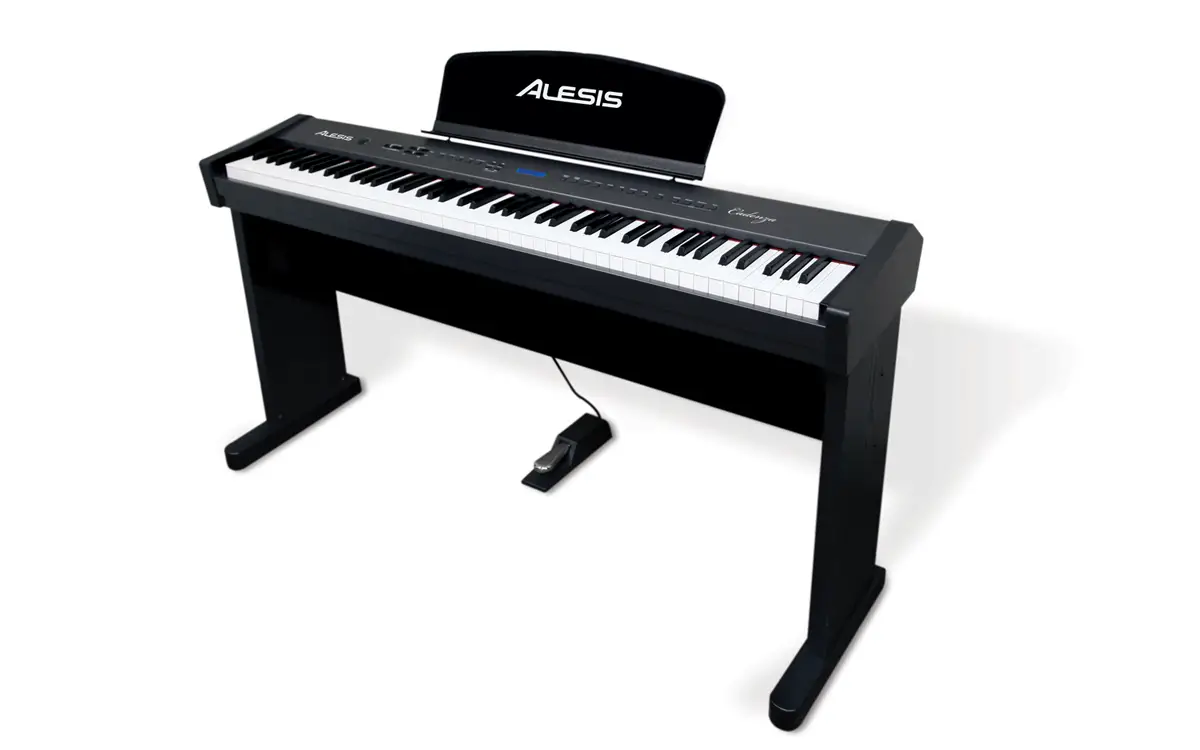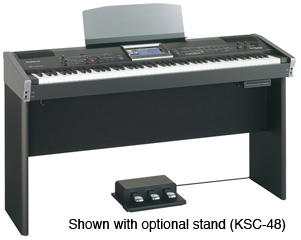We’ve already discussed different types of keyboard, so here we take a closer look at what exactly is meant by “semi-weighted” keys on a digital piano or other keyboard instrument, and whether they are a good fit for the kind of musician you are and the styles of music you’d like to play.
What is a semi-weighted keyboard?
A semi-weighted keyboard features keys that are partially weighted, with a spring mechanism designed to give the player a greater degree of control over the volume and tone of the notes they play. Semi-weighted keyboards are designed to strike a balance between the light, unweighted keys of a synthesizer and the heavier, fully-weighted keys of an acoustic or high-end digital piano.
It is unlikely that the weight will be graded as is often found on a digital piano, which mimics the feel of an acoustic piano, whereby the lower notes have more resistance than the higher notes. The weighting will be uniform across the entire range of the keyboard.
Semi-weighted keyboards are typically constructed with a combination of weighted and unweighted components, as well as specialized mechanisms to provide tactile feedback to the player.
The keys are partially weighted, typically using a combination of springs and weights to create resistance when the player strikes the key. The keys are often made of plastic, but some higher-end models may use wood or other materials.
Unlike fully weighted keyboards, which use a hammer action to simulate the feel of an acoustic piano, semi-weighted keyboards typically use a simpler mechanism to provide tactile feedback. The mechanism may consist of a lever or spring that creates resistance when the player presses down on the key.
Underneath each key, there are sensors that detect when the key is pressed and released. These sensors send signals to the keyboard’s internal sound engine, which generates the corresponding sound.
What are the advantages of a semi-weighted keyboard?
The keys on a semi-weighted keyboard have a moderate resistance that can help the player add expression and nuance to their playing, making it a popular choice for musicians who need more tactile feedback than what an unweighted keyboard can provide, but don’t necessarily require the full range of touch sensitivity of a fully weighted keyboard. Semi-weighted keyboards are commonly used in electronic music, as well as in live performance situations where portability and versatility are key considerations.
Some of the advantages of using a semi-weighted keyboard include:
- Enhanced expressiveness: Semi-weighted keys provide a more tactile feel than unweighted keys, which can help musicians add more expression to their playing. The keys are designed to respond to subtle variations in touch, allowing for a greater degree of dynamic control.
- Portability: Compared to fully weighted keyboards, semi-weighted keyboards tend to be more compact and lightweight, making them a popular choice for musicians who need a portable instrument they can take on the road.
- Cost-effective: Semi-weighted keyboards are typically less expensive than fully weighted keyboards, making them a good choice for musicians who want a more responsive keyboard without breaking the bank.
- Versatility: Semi-weighted keyboards are suitable for a wide range of musical genres, from classical and jazz to electronic and pop music. They can be used in both live performance and recording settings, making them a versatile tool for musicians and producers.
Overall, the semi-weighted keyboard strikes a good balance between the expressiveness of a fully weighted keyboard and the portability and affordability of an unweighted keyboard, making it a popular choice for many musicians.
What are some disadvantages of a semi-weighted keyboard?
While semi-weighted keyboards offer several advantages, there are also a few potential disadvantages to consider:
- Limited touch sensitivity: Compared to fully weighted keyboards, semi-weighted keyboards typically have less touch sensitivity. This means that players may not be able to achieve the same level of nuance and expression in their playing as they would with a fully weighted keyboard.
- Reduced durability: Semi-weighted keyboards may be more prone to wear and tear than fully weighted keyboards, as the key mechanism is often more complex and may require more maintenance.
- Limited range: Depending on the specific model, semi-weighted keyboards may have a limited range of keys, which can be a disadvantage for musicians who need a wider range of notes.
- Less authentic feel: While semi-weighted keyboards can offer a more tactile feel than unweighted keyboards, they may not provide the same level of realism and authenticity as a fully weighted keyboard. This can be a drawback for musicians who are used to playing acoustic pianos and want an instrument that closely replicates that experience.
Who is most suited to using a semi-weighted keyboard?
Semi-weighted keyboards are most suited to musicians who require a more tactile feel than an unweighted keyboard can provide, but do not necessarily require the full range of touch sensitivity of a fully weighted keyboard. Here are some examples of musicians who might find a semi-weighted keyboard to be a good fit:
- Electronic musicians: Semi-weighted keyboards are popular among electronic musicians who need an instrument that is easy to transport and can be used in a variety of live performance and recording settings. They provide a more responsive feel than unweighted keyboards, which can help musicians add expression and nuance to their playing.
- Singer-songwriters: Semi-weighted keyboards can be a good choice for singer-songwriters who need an instrument that is easy to set up and play. They provide a balance of tactile feedback and portability, making them a good fit for musicians who need an instrument that can be taken on the road.
- Music students: Semi-weighted keyboards can be a good choice for music students who are learning to play piano or keyboard. They offer a more realistic feel than unweighted keyboards, which can help students develop their touch and technique.
- Home studio producers: Semi-weighted keyboards can be a good fit for home studio producers who need an instrument that can be used to record MIDI data and control virtual instruments. They provide a more responsive feel than unweighted keyboards, which can help producers add more expression and nuance to their productions.
Which manufacturers make and sell semi-weighted keyboard keyboards?
There are many music instrument manufacturers that produce semi-weighted keyboards. Some of the most popular and reputable manufacturers include:
- Roland: Roland produces a range of semi-weighted keyboards under its popular Juno and FA series, as well as other models like the RD-88.
- Korg: Korg produces semi-weighted keyboards under its popular Kross and Kronos series, as well as other models like the SV-2 and Krome.
- Yamaha: Yamaha produces a range of semi-weighted keyboards under its popular MOXF and MODX series, as well as other models like the CP73.
- Nord: Nord produces a range of semi-weighted keyboards under its Stage and Electro series, as well as other models like the Wave and Lead.
- Arturia: Arturia produces the KeyLab series of semi-weighted keyboards, as well as other models like the MicroFreak and MiniLab.
- Novation: Novation produces the SL MKIII series of semi-weighted keyboards, as well as other models like the Launchkey and Impulse.
How much variance is there between different models?
Semi-weighted keyboards can vary significantly between manufacturers and models in terms of features, quality, and price.
The key mechanism can vary significantly between keyboards, which can affect the feel and responsiveness of the instrument. Some keyboards use a simple lever or spring mechanism, while others use more advanced hammer-action mechanisms.
Semi-weighted keyboards can range from 25 keys to 88 keys, with 49 and 61-key models being the most common. The number of keys can impact the portability and versatility of the instrument.
The price can vary significantly between manufacturers and models, with some models costing a few hundred dollars, while others can cost several thousand dollars.
Should I buy a semi-weighted keyboard?
Ultimately the decision comes down to considering all the factors about how you’ll play and use the instrument.
If you are looking for an authentic piano experience, you will want to buy a digital piano with fully weighted keys.
However if you want a keyboard with a bit more weight to it than synth/organ keys, but which is still fast to play and with greater portability, a semi-weighted keyboard instrument is likely to be the bets choice.
Some digital piano models do use a semi-weighted keyboard. These will not provide such a high level of authenticity as a fully weighted version. They are often low to mid-range instruments designed to strike a balance between the playing experience and portability for gigging musicians.
It’s worth trying a few different models for yourself before deciding what the best instrument is for your needs.





